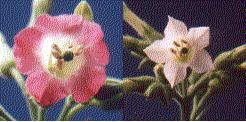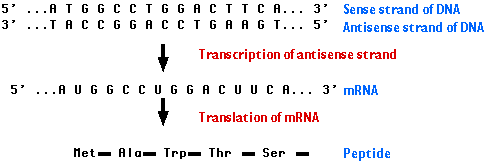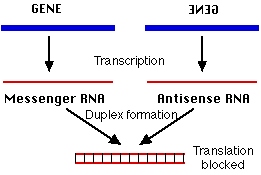
Messenger RNA (mRNA) is single-stranded. Its sequence of nucleotides is called "sense" because it results in a gene product (protein). Normally, its unpaired nucleotides are "read" by transfer RNA anticodons as the ribosome proceeds to translate the message. (See mechanism of translation.)

However, RNA can form duplexes just as DNA does. All that is needed is a second strand of RNA whose sequence of bases is complementary to the first strand; e.g.,
5´ C A U G 3´ mRNAThe second strand is called the antisense strand because its sequence of nucleotides is the complement of message sense. When mRNA forms a duplex with a complementary antisense RNA sequence, translation is blocked.
3´ G U A C 5´ Antisense RNA
 This may occur because
This may occur because
With recombinant DNA methods, synthetic genes (DNA) encoding antisense RNA molecules can be introduced into the organism.
Most tomatoes that have to be shipped to market are harvested before they are ripe. Otherwise, enzymes synthesized by the tomato cause them to spoil before they reach the customer.
Transgenic tomatoes have been constructed that carry in their genome an artificial gene (DNA) that is transcribed into an antisense RNA complementary to the mRNA for an enzyme involved in spoilage. These tomatoes make only 10% of the normal amount of the enzyme.
The goal of this work was to provide supermarket tomatoes with something closer to the appearance and taste of tomatoes harvested when ripe. However, these tomatoes often became damaged during shipment and handling and have been taken off the market.
| Right: Flower of a tobacco plant carrying a transgene whose transcript is antisense to one of the mRNAs needed for normal flower pigmentation. Left: Flower of another transgenic plant that failed to have its normal pigmentation altered. (Courtesy of van der Krol, et. al., from Nature 333:866, 1988.) |  |
In this respect, it is easier to produce transgenic plants than transgenic animals.
Do cells contain genes that are naturally translated into antisense RNA molecules capable of blocking the translation of other genes in the cell? Recently a few cases have been found and these seem to represent another method of regulating gene expression.
In both mice and humans, the gene for the insulin-like growth factor 2 receptor (Igf2r) that is inherited from the father synthesizes an antisense RNA that appears to block synthesis of the mRNA for Igf2r. An inherited difference in the expression of a gene depending on whether it is inherited from the mother or the father is called genomic or parental imprinting.
| Imprinting of the Igf2r gene. |
| Welcome&Next Search |